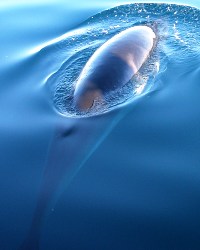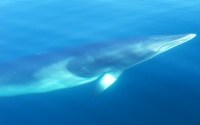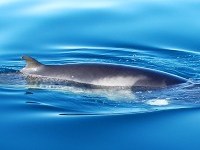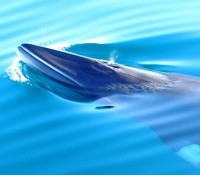(949) 675-0551 |
 |
DESCRIPTION: The minke whale is the smallest member of the rorqual family which means that they have baleen plates, a dorsal fin, and throat plates. There are three different subspecies. One is the Antarctic minke whale. The others are the common minke whale and the dwarf minke whale. The common minke whale is in the Northern Hemisphere and the dwarf minke whale is in the Southern Hemisphere. They subspecies look similar. They are both black and grey on the dorsal (upper) side and white in the ventral (under) side. Some have a light colored chevron on their backs and those not from the Antarctic have a white band on each flipper. They have a very distinctive snout. It is triangular and smaller in proportion to other rorquals. They range in size from 25-35 feet and weigh up to 10 tons with the females being larger in order to care for their young. Their dorsal fins are located 2/3 of the way down the back and are tall and falcate (curved). The flukes are ¼ of the body length and are notched in the center. Being so small, their spout may be hard to see and disappears quickly. They also exhale before surfacing which makes the blow smaller. The lifespan of a minke whale is 30-50 years. |
 |
RANGE/HABITAT: The minke whale is seen in almost every ocean but tends to prefer icy waters. They are most abundant in the southern hemisphere. Minke whales in the northern hemisphere prey mostly on small schooling fishes; those in the southern hemisphere prey mostly on krill. Their eating habits are similar to that of the blue whale. Some of these whales migrate for their food and some stay in one place year-round. |
 |
BEHAVIOR: The Minke whale uses its 280-300 baleen plates to trap small fish, krill, and water inside their mouths. They use their tongues to push the water out. They have 50-70 throat plates that expand when they eat and help the whale take in more food. Minke whales are solitary creatures but can sometimes be seen in small pods up to 6 whales. Females and males tend to separate with the males out at sea and the females remaining close to shore. These whales are very curios and will sometimes come up to moving boats and follow them. Because of their size, most of their body can been seen when they come up to breathe. They do not raise their flukes or breach and can stay submerged for 20 minutes. |
| MATING/BREEDING: Both males and females reach sexual maturity at ages 6-8 and breed in the summertime. They give birth every 1-2 years after an 11 month gestation period. The calves are 8-10 feet and can weigh up to 1000 pounds. They nurse on their mother's milk for 6-10 months before changing to solids. STATUS: Because of the minke whale's small size, they were not targets of whaling until the larger whales were becoming depleted or protected. They were being targeted in multiple locations but only on a small scale. In 1986, there was a general moratorium put on whaling of all species with an exception to minke whales around Japan and Norway. Now they are being taken for research into whether or not to resume sustainable commercial whaling. |
|
 |
|
For Reservations Call: |
||
(949)675-0551 |
||
Newport Beach Whale Watching 309 Palm St. #A - Newport Beach CA. 92661 |
||
Copyright © 2001 Newport Landing
Whale Watching |
Whale Watching | Whale Watching Dana Point Visitors | Whale Watching Long Beach Visitors | Whale Watching Los Angeles Visitors
Whale Watching San Diego Visitors | Huntington Beach Whale Watching | Whale Watching Laguna Beach | Catalina Island Whale Watching